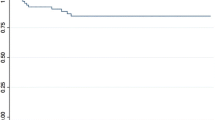Summary
Surgery following chemotherapy for treatment of metastatic testis cancer is reserved for partial remissions with localized tumors considered resectable. After primary chemotherapy, about 90% will have teratoma or necrosis and only 10% will have cancer. The concept of two cycles of post operative chemotherapy in this small group with cancer is supported by a 70% long term cure rate. A more difficult group of patients are those who have had not only primary but also salvage chemotherapy for refractory tumor. About 55% of these patients undergoing post (salvage) chemotherapy RPLND surgery have persistent cancer in the resected specimen. There is no data to support the routine use of repeat salvage chemotherapy post operatively. Of 91 patients presenting for surgery post salvage chemotherapy, 53 were considered completely resected and 36 incompletely resected. Of the 53 realistic candidates for cure with complete resections, 25 were given post operative repeat salvage chemotherapy and 28 received none. 9 (36%) receiving more chemotherapy remained NED and 12 (43%) receiving none remained NED. 12 in each group died of disease. Therefore, there is no data to support routine repeat salvage chemotherapy in patients considered completely resected who had already received salvage chemotherapy pre-operatively. Rather the outcome in this cohort depends more on the completeness of its resectability.
Similar content being viewed by others
References
Einhorn LH (1990) Treatment of testicular cancer: a new and improved model (editorial). J Clin Oncol 8:1777–1781
Donohue J, Rowland R (1984) The role of surgery in advanced testicular cancer. Cancer 54:2716–2721
Loehrer P, Hui S, Clark S, et al (1986) Teratoma following cisplatin-based combination chemotherapy for nonseminomatous germ cells tumors: a clinicopathologic correlation. J Urol 135:1183–1189
Einhorn L, Williams S, Mandelbaum I, et al (1981) Surgical resection in disseminated testicular cancer following chemotherapeutic cytoreduction. Cancer 48:904–908
Geller N, Bosl G, Chan E (1989) Prognostic factors for relapse after complete response in patients with metastatic germ cell tumors. Cancer 63:440–445
Ulbright T, Roth L (in press) Testicular and paratesticular neoplasms. In: Sternberg S (ed) Diagnostic surgical pathology. Raven, New York
Ulbright T, Roth L (1990) A pathologic analysis of lesions following modern chemotherapy for metastatic germ cell tumors. Pathol Annu 25:313–340
Davey D, Ulbright T, Loehrer PJ, et al (1987) The significance of atypia within teratomatous metastases after chemotherapy for malignant germ cell tumors. Cancer 59:533–539
Fox EP, Loehrer PJ (1991) Chemotherapy for advanced testicular cancer. Hematol Oncol Clin North Am 5:1173–1187
Einhorn L, Williams S, Troner M, et al (1981) The role of maintenance therapy in disseminated germ cell cancer. N Engl J Med 305:727–731
Bosl G, Gluckman R, Geller N, et al (1986) VAB-6: an effective chemotherapy regimen for patients with germ-cell tumors. J Clin Oncol 4:1439–1499
Einhorn L, Williams S, Loehrer PJ, et al (1989) Evaluation of optimal duration of chemotherapy in favorable-prognosis disseminated germ cell tumors: a southeastern cancer study group protocol. J Clin Oncol 7:387–391
Williams S, Birch R, Einhorn L, et al (1987) Treatment of disseminated germ cell tumors with cisplatin, bleomycin and either vinblastine or etoposide. N Engl J Med 316:1435–1440
Stoter G, Vendrik C, Struyvenberg A, et al (1984) Five year survival of patients with disseminated nonseminomatous testicular cancer treated with cisplatin, vinblastine, and bleomycin. Cancer 54:1521–1524
Vugrin D, Whitemore WF, Sogani P, et al (1981) Combined chemotherapy and surgery in treatment of advanced germ-cell tumors. Cancer 47:2228–2231
Tonkin KS, Rustin GJS, Wignall B, et al (1989) Successful treatment of patients in whom germ cell tumour masses enlarged on chemotherapy while their serum tumour markers decreased. Eur J Clin Oncol 25:1739–1745
Bosl G, Geller N, Vogelzang N, et al (1987) Alternating cycles of etoposide plus cisplatin and VAB-6 in the treatment of poor-risk patients with germ cell tumors. J Clin Oncol 5:436–440
Logothetics C, Samuels M (1984) Surgery in the management of stage III germinal cell tumors. Observations on the M. D. Anderson Hospital experience, 1971–1979. Cancer Treat Rep 11:27–37
Williams S, Stablein D, Einhorn L, et al (1987) Immediate adjuvant chemotherapy versus observation with treatment at relapse in pathological stage II testicular cancer. N Engl J Med 317:1433–1438
Hartlapp JH, Weibach L, Horstmann-Dubral G (1988) Adjuvant chemotherapy in nonseminomatous testicular tumor stage IIB (abstract 464). Proc Am Soc Clin Oncol 7:120
Nichols CR, Andersen J, Lazarus HM, et al (1992) High-dose carboplatin and etoposide with autologous bone marrow transplantation in refractory germ cell cancer: an Eastern Cooperative Oncology Group protocol. J Clin Oncol 10:558–563
Author information
Authors and Affiliations
Rights and permissions
About this article
Cite this article
Donohue, J.P., Fox, E.P., Williams, S.D. et al. Persistent cancer in postchemotherapy retroperitoneal lymph-node dissection: outcome analysis. World J Urol 12, 190–195 (1994). https://doi.org/10.1007/BF00185671
Issue Date:
DOI: https://doi.org/10.1007/BF00185671




